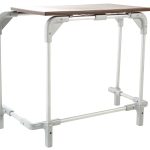Introduction
The global crisis of plastic pollution has become one of the most pressing environmental issues of our time. Traditional plastic production, heavily reliant on fossil fuels, releases significant amounts of greenhouse gases, contributing to climate change. Additionally, the non-biodegradable nature of conventional plastics means they persist in the environment for centuries, accumulating in our oceans, landscapes, and even within the food chain. In this context, eco-friendly plastic chairs emerge as a sustainable seating solution, offering a way to reduce environmental impact without compromising on functionality or design. By choosing sustainable seating solutions, consumers and businesses alike can play a part in mitigating the negative effects of plastic pollution and contribute to a healthier planet.
The Problem with Traditional Plastic Chairs
Environmental Impact
The environmental implications of traditional plastic chairs are manifold. Firstly, they are predominantly made from non-renewable petroleum-based polymers that are non-biodegradable. This means once they’re discarded, they linger in the environment indefinitely, contributing to land and marine pollution. The production process itself is energy-intensive and generates a s§ubstantial carbon footprint, exacerbating global warming and climate change.
Health Concerns
Beyond the environmental toll, traditional plastic chairs often contain harmful chemicals, such as phthalates, BPA, and other additives used to enhance colour, flexibility, or durability. These substances can leach out over time, posing health risks to humans, including endocrine disruption, reproductive issues, and increased cancer risk. The production process also exposes workers and nearby communities to toxic emissions, further underscoring the need for safer, more sustainable materials.
Contribution to Global Pollution
Plastic waste from products like traditional chairs significantly contributes to global pollution. With over 300 million tons of plastic produced annually, a significant portion ends up in landfills, waterways, and oceans, where it breaks down into microplastics. These microplastics are ingested by wildlife, leading to lethal consequences and entering the human food chain, highlighting an urgent need for alternatives.
What Makes a Plastic Chair Eco-Friendly?
Materials
Eco-friendly plastic chairs are made from alternative materials that lessen environmental impact. Recycled plastics, sourced from post-consumer or post-industrial waste, significantly reduce the need for virgin plastic production. Bioplastics, made from renewable resources like corn starch, sugarcane, or cellulose, offer a more sustainable and sometimes biodegradable option, although their environmental benefits can vary based on the specifics of their production and disposal.
Manufacturing Process
The manufacturing process of eco-friendly plastic chairs focuses on energy efficiency and minimal waste production. Advanced technologies and methods are employed to reduce energy consumption and greenhouse gas emissions. Some manufacturers also implement zero-waste or closed-loop systems, where all material byproducts are reused or recycled, minimising the environmental footprint.
Design and Durability
Sustainability is also a matter of design and durability. Eco-friendly plastic chairs are often designed with longevity in mind, featuring timeless aesthetics and robust construction to discourage disposability and frequent replacements. The emphasis on durability ensures that these chairs can withstand regular use for many years, ultimately reducing the demand for new products and the resources required to make them.
Certifications and Standards
Certifications and standards play a crucial role in identifying eco-friendly products. Look for chairs that have been awarded environmental certifications like the Cradle to Cradle Certified™, GREENGUARD, or certifications indicating the use of recycled content. These certifications ensure that the products meet stringent sustainability criteria, covering aspects such as material health, resource reuse, and renewable energy use in production.
Choosing eco-friendly plastic chairs represents a tangible step towards more sustainable living and working environments. By prioritising materials, processes, and designs that reduce environmental impact, consumers can help drive the demand for more sustainable products, encouraging manufacturers to innovate and adopt greener practices.
Benefits of Eco-Friendly Plastic Chairs
Reduced Environmental Impact
Eco-friendly plastic chairs significantly lower the environmental footprint associated with furniture. By utilising recycled materials or renewable resources, these products decrease the reliance on virgin plastics, which in turn reduces the carbon footprint and overall waste production. Less waste means fewer materials ending up in landfills and oceans, contributing to a cleaner and healthier planet. Additionally, the energy-efficient manufacturing processes associated with eco-friendly plastic chairs further minimise environmental impact.
Health Benefits
One of the paramount benefits of eco-friendly plastic chairs is the absence of harmful chemicals commonly found in traditional plastics, such as BPA, phthalates, and lead. These chemicals can leach out and pose health risks to humans, including hormonal disruptions and increased cancer risk. Eco-friendly chairs are often made with materials that are safer for both consumers and the environment, ensuring a healthier indoor air quality and reducing exposure to toxic substances.
Economic Advantages
Eco-friendly plastic chairs are designed with durability in mind, which translates to longer lifespans and less frequent need for replacements. This durability not only saves money over time but also contributes to reducing the demand for new raw materials and the energy consumption associated with manufacturing new products. In the long term, investing in eco-friendly chairs can lead to significant savings, both economically and environmentally.
Contribution to a Circular Economy
By promoting the use of recycled materials and designs that are recyclable at the end of their life cycle, eco-friendly plastic chairs support the principles of a circular economy. This economic system aims to eliminate waste and the continual use of resources, encouraging recycling and reuse. Eco-friendly chairs can be recycled at the end of their lifespan, ensuring that materials are re-integrated into the manufacturing process, thus minimising waste and resource extraction.
Popular Eco-Friendly Materials for Plastic Chairs
Recycled PET (Polyethylene Terephthalate)
Recycled PET, derived from used plastic bottles and containers, is a popular material for making eco-friendly plastic chairs. Recycling PET reduces landfill waste and the demand for virgin plastic. Chairs made from recycled PET are durable, lightweight, and can themselves be recycled, making them an excellent option for sustainable furniture.
Bioplastics
Bioplastics are made from renewable resources like corn starch, sugarcane, or cellulose. Unlike traditional plastics derived from fossil fuels, bioplastics have a smaller carbon footprint and, in some cases, are biodegradable or compostable under the right conditions. This makes them an appealing choice for reducing environmental impact and supporting renewable industries.
Recycled Polypropylene and High-Density Polyethylene (HDPE)
Recycled polypropylene and HDPE are other common materials used in eco-friendly plastic chairs. These plastics are widely recycled and can be reprocessed into new products with minimal quality loss. Chairs made from these materials are strong, resistant to fatigue, and can withstand exposure to a wide range of temperatures, making them suitable for both indoor and outdoor use.
By opting for eco-friendly plastic chairs made from materials like recycled PET, bioplastics, and recycled polypropylene or HDPE, consumers and businesses can enjoy durable, stylish, and sustainable furniture options that contribute positively to the environment and society.
Choosing the Right Eco-Friendly Plastic Chair
Identifying Truly Sustainable Products
When selecting an eco-friendly plastic chair, it’s crucial to look beyond the surface. Certifications such as GREENGUARD, Cradle to Cradle, and others that signify recycled content or low emissions can guide you towards truly sustainable options. These certifications ensure that the products meet stringent environmental and health standards throughout their lifecycle. Additionally, products that openly disclose their recycled material content offer transparency, helping consumers make informed decisions.
Considerations for Durability, Design, and Functionality
Durability is key to sustainability. A chair that lasts longer reduces the need for frequent replacements, thereby conserving resources. Evaluate the build quality and materials used to ensure they can withstand regular use over time. The design should not only be aesthetically pleasing but also functional and ergonomic, enhancing the user’s comfort and well-being. Consider how the chair fits with your intended use, whether it’s for home, office, or outdoor settings.
Tips for Responsible Disposal and Recycling
At the end of its life cycle, an eco-friendly chair should be disposed of responsibly. Check if the manufacturer offers a take-back program for recycling or repurposing. If not, research local recycling facilities to see if they accept the materials your chair is made from. Sometimes, parts of the chair can be recycled separately, so it’s worth investigating the most environmentally friendly way to break it down.
The Future of Sustainable Seating
Innovations on the Horizon
The future of sustainable seating looks promising with ongoing innovations in materials and manufacturing processes. Biodegradable plastics, derived from natural sources, offer a solution that reduces long-term waste. Zero-waste manufacturing aims to fully utilise raw materials, minimising environmental impact. These advancements promise to revolutionise the industry by creating products that are not only sustainable but also return to the earth harmlessly at the end of their lifecycle.
The Role of Consumer Demand
Consumer demand plays a pivotal role in driving sustainability within the furniture industry. As more people seek out and prioritise eco-friendly options, manufacturers are incentivized to adopt greener practices and develop new, sustainable products. This demand not only influences existing companies but also encourages the emergence of new brands dedicated to sustainability, further enriching the market.
Sustainable Practices and Quality Design
Sustainable practices often lead to better quality and more innovative design. Designers are challenged to think creatively about the use of materials, production processes, and the product life cycle, leading to unique and functional designs. Sustainable furniture often tells a story of craftsmanship, innovation, and environmental responsibility, adding value beyond mere functionality.
Conclusion
Choosing eco-friendly plastic chairs is more than a personal preference; it’s a commitment to environmental stewardship and health. By selecting sustainable seating solutions, consumers contribute to reducing the ecological footprint of furniture production and encourage the industry to adopt more responsible practices. This guide underscores the importance of informed choices, from identifying truly sustainable products to considering their end-of-life disposal.
As we look towards the future, the potential for innovations such as biodegradable materials and zero-waste manufacturing holds promise for even more sustainable furniture options. The role of consumer demand in this evolution cannot be overstated; it’s the driving force that will continue to push the industry towards greener horizons.
In conclusion, let’s not only embrace eco-friendly plastic chairs but also champion sustainable living in all areas of our lives. Support brands that prioritise the environment, advocate for policies that protect our planet, and educate others about the benefits of sustainable choices. Together, we can make a significant impact, one chair at a time. Contact us today !








